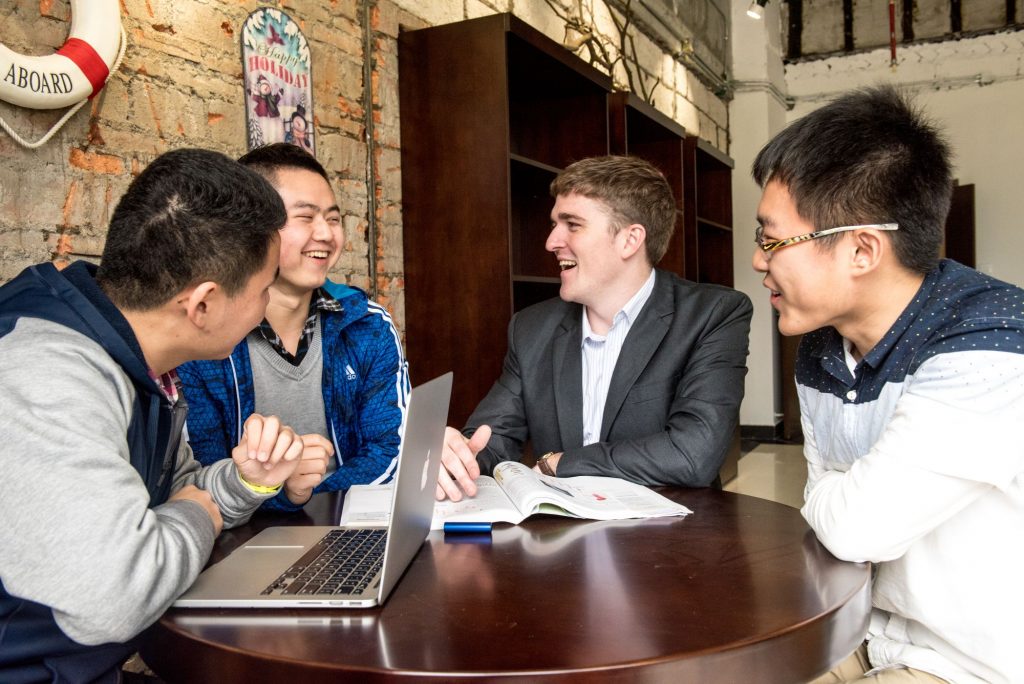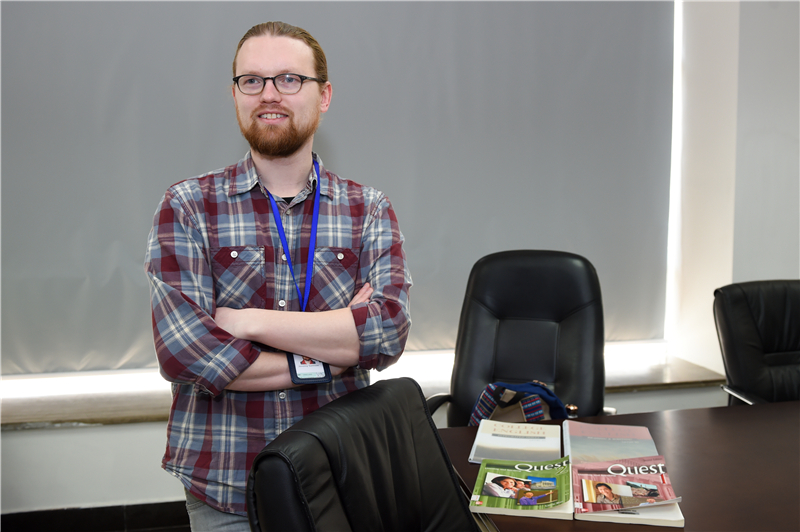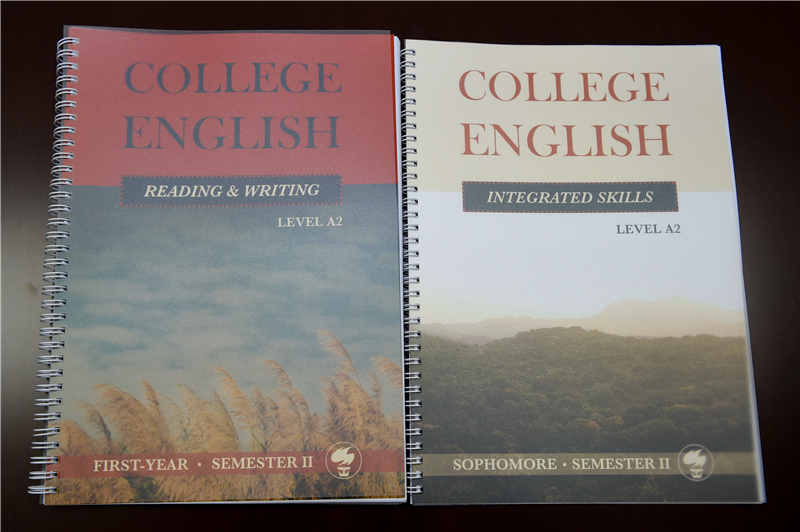When the new term begins, we can see many new foreign faces on SUSTech campus, in the teaching buildings or in the dining halls. Are they visitors to SUSTech or new members in the University?
Actually, they are foreign teachers working in the newly-established SUSTech Language Center. What surprises will the long-awaited Center bring to us? Days ago, the journalist interviewed the new English teachers in the Center.
From line & row class layout to group layout – view the open teaching philosophy through the new design in the classroom & textbooks

After SUSTech Language Center was put into operation, the first change happened to the classroom layout. Abandoning the traditional line & row pattern, the classrooms are now in the group layout. When giving lectures, teachers can walk off the podium and join the students. This is the first step towards interactive teaching.
Classroom walls are also having more contents. Mobile whiteboard is hung on blackboards. And deep-blue notice board is now seen on walls, on which students can use hobnails to place anything they want such as photos, pictures, articles or even weird artworks. They can “scrawl” on classroom walls if they like it. Creativity and imagination of students are liberated in English classes. The colorful notice board has become the personality biz card of the class.
New English textbooks developed by SUSTech are very practical, which perfectly represent the Center’s philosophy of designing English classes. Different from the previous textbooks which arrange structure based on writing style and contents, the new textbooks are based on skills. For instance, in the section that trains reading, the textbooks require students “quickly get facts and author’s opinion in English reading”, “predict the following part”, “comprehend intention of the author”, “understand what is behind the words”. In each section, the discrimination & analysis exercises and fun games help students gradually develop reading skills through theoretical analysis and practice.
Teach English communication, not teach English – rebuild the correct concept of “fluent English”

Jeremy Samsoe, English Teaching Adviser to SUSTech Language Center

SUSTech English textbooks
When asked why English classes don’t focus on systematic grammar teaching, Jeremy Samsoe from Temple University in US, who is now the English Teaching Adviser to SUSTech Language Center, responds the Language Center is not “teaching students English”, but “teaching them how to communicate in English”. In the process of communication and practice, problems are detected and systematic knowledge is given to them, trying to solve the problems. In this way, the students would not waste time to learn English knowledge that is useless. At the same time, they are able to put the English knowledge in practice.
According to Jeremy, many students judge their English level through the size of English glossary. This is not the right way. In life, but not in textbooks, language (English) is a tool used to communicate. And the core of communication is understanding. What is most important is to convey your ideas to the person you talk to in the way he/she can understand it, and comprehend the ideas of his/hers. A person mastering 2,000 words might use his/her glossary to communicate very well with others. But one mastering more than 10,000 words might read English only and cannot speak English. As a result, teaching that is targeted at communication maximizes efficiency of English learning and keeps the students out of the trap of “deaf and dumb English”.
Language learning should focus on “output” – fun class trains ability of presentation
About presentation, Jeremy mentions that Americans, since primary school period, start to make presentation practice. However, Chinese students start the practice only in college. So the Chinese students seriously lack such experience. Besides, the Chinese students don’t quite understand the meaning of presentations. “It is very important. In your workplace, you have to tell your ideas and persuade others. And presentation is an very important ability.”
In China, traditional English teaching emphasizes more on “input”(words and reading) than on “output” (oral English and writing). Jeremy finds the effective way is that teachers guide students to be brave and confident to express themselves.
“Chinese students are always worried they make mistakes. Actually, they don’t have to. When giving scores, the most important thing we consider is that they are able to express themselves. Grammar and pronunciation are second to this point. If students can express themselves very well, the communication is effective”. He expresses his idea at the Workshop of Foreign Teachers for Sophomores, which receives unanimous agreement from professors. As a result, the students are always encouraged to show confidence and forsake the worry about making mistakes.
Jeremy also mentions the most important point in presentation is the body language. Proper body language can help provide more effective information and enhance effect of expression.
Concerning expression of body language, Rachel Luckett, professor of English listening & speaking for freshmen, asks the students to read aloud English paragraphs in groups and give scores to each other’s body language. “I hope they forget about their pronunciation, never be afraid of making mistakes and express themselves boldly in body language”. She also has her own unique teaching methods, and designs her English class in the personalized way of “separate-integrate”. According to Rachel, presentation is composed of a few parts, such as voice, body language and confidence. And these abilities can be gained separately from glossary.
Each teacher in SUSTech Language Center has his/her own teaching methods. Tyler Luckett, another teacher in the Center, asks his students to make “silent presentations” in the class so that they can practice their facial expression, action and walk onto/off the podium. The topics of presentations set by Tyler are often very funny. And students, in the nature-liberating process, gradually understand how to express themselves on the podium and how to use their body language in a natural way.
Develop the ability of learning from academic literature – SUSTech Language Center is an academic center
Jeremy Samsoe has his own ideas about discipline integration.
“Before reading academic literature, students carefully read the literature abstract and use search engines such as Wikipedia. In this way, they can have general understanding of major contents in the literature and improve reading efficiency”.
He points out that students today are not able to distinguish between plagiarism and reference. Some plagiarism problems are not caused intentionally because students find it difficult to define correctly reference and plagiarism. They don’t have clear-cut understanding of reference to the author’s ideas or clearly know the rules of reference. “For a research university like SUSTech, it is important to cultivate the students’ ability to write thesis by following the international academic rules, and it provides the students with very important ability reserve for their future academic life. As a result, it is a big issue to teach students how to refer to academic literature. ”, he says seriously, “In general, if the overall similarity in a thesis exceeds 10%, we can define it as the plagiarism. And the reference should be clearly stated. However, we strongly recommend that you should master the ideas and essence of the literature in your reference before expressing your own ideas in your own language. This is a process of learning and it is reference, not plagiarism.”
In the brainstorm-like workshop of listening & speaking teachers for sophomores, the foreign teachers voice their opinions. For instance, by playing the TED speeches or funny video clips on Youtube, they help students understand what a serious problem it is to do plagiarism. After that, by making in-class practice, they teach students how to correctly use reference literature.
Academic presentation is a creative idea in English listening & speaking class for sophomores. “To help students better understand employment future of different majors, we will ask sophomore students to make presentations in relevant disciplines for lower-grade students”. According to Jeremy Samsoe, though SUSTech students select majors in Year 3 and have enough time to think elaborately, most students don’t quite understand the employment future of different majors. As a result, the university helps senior-grade students understand it before telling their understanding to lower-grade students by making presentations. In this way, the students not only have better understanding but also have their presentation skill trained. “In this process, sophomores not only learn English, but also have deep and practical knowledge of their major while sharing it with the lower-grade students.”
Teaching actually means learning out of teaching – respect equality philosophy and grow together with students
When talking with Jeremy and other foreign teachers in SUSTech Language Center, we find the philosophy of equality is deeply rooted in the heart of all teachers. The teachers are not only positioned as teachers, but also as students. They maintain the open mentality and hope to learn from students and grow together with them.
Rachel is not the sole teacher who works hard on brainstorm and keeps adjusting teaching methods. Teachers engage in brainstorm in many places, the Adviser Jeremy believes “communication first”, and the Director Kathy of SUSTech Language Center adopts the leading philosophy of “integrated English”, revealing English classes are now favored by students. Freshmen and sophomores say, “English classes are now more interesting, different from the previous ones.”
Outside the class, teachers “are also trying” to get integrated into SUSTech campus. They often play volleyball or have lunch/dinner with students. Foreign teachers are seen in the dining halls. Their friendly smiles encourage students to chat with them. In the interview, foreign teachers say they are willing to talk with students, hoping they don’t get nervous in the process of communications because mistake-making cannot be avoided. They hope all students can become successful communicators.
Proofread By
Photo ByCenter for Language Education